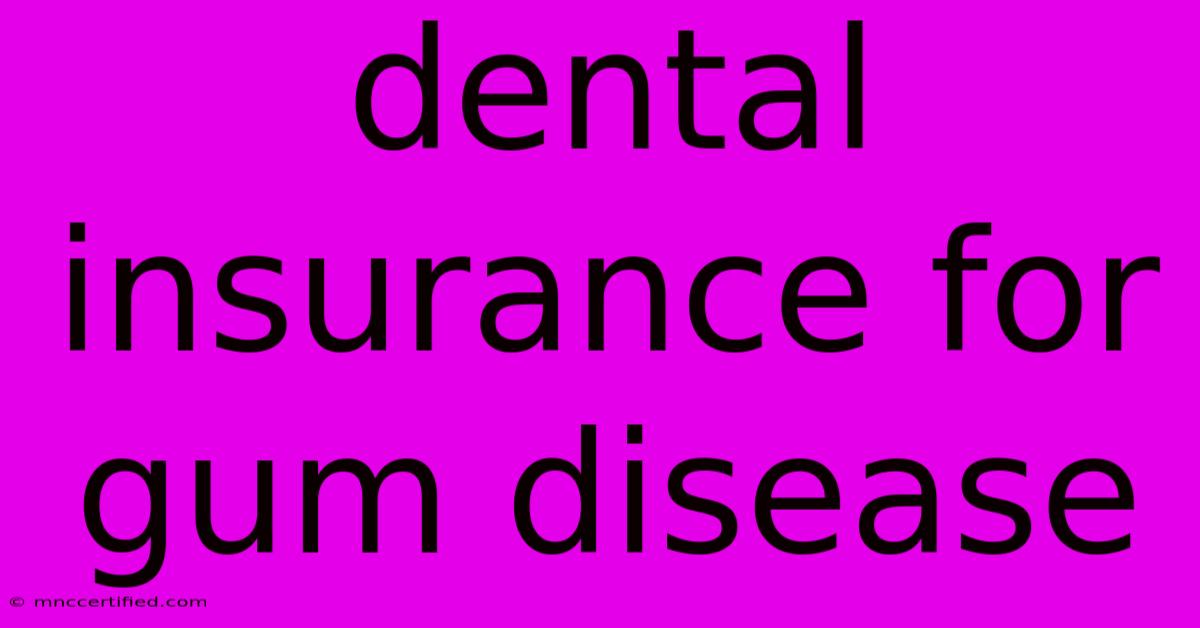Dental Insurance For Gum Disease

Table of Contents
Dental Insurance for Gum Disease: What You Need to Know
Gum disease, also known as periodontal disease, is a serious infection affecting the gums and bones supporting your teeth. Left untreated, it can lead to tooth loss and other health problems. Understanding your dental insurance coverage for gum disease treatment is crucial for maintaining your oral health and managing costs. This article explores the intricacies of dental insurance and its role in covering gum disease treatment.
Understanding Gum Disease and its Stages
Gum disease progresses through several stages:
-
Gingivitis: This is the initial and most easily reversible stage. It's characterized by inflamed, bleeding gums. Good oral hygiene practices, including brushing and flossing, often suffice to reverse gingivitis. Most dental insurance plans cover preventative care, including checkups and cleanings that can help detect and treat gingivitis early.
-
Periodontitis: This is a more advanced stage where the infection has spread to the deeper tissues and bone supporting the teeth. Periodontitis requires more extensive treatment, potentially including scaling and root planing (deep cleaning), antibiotic therapy, and even surgery. The cost of these procedures can be significant.
Dental Insurance Coverage for Gum Disease Treatment
The extent of your dental insurance coverage for gum disease treatment depends on several factors:
-
Your specific plan: Different dental insurance plans have varying levels of coverage. Some plans may only cover preventative care, while others offer more comprehensive coverage, including periodontal treatment. Carefully review your policy's benefit schedule to understand what's covered and any limitations. Look for terms like "periodontal disease," "scaling and root planing," and "gum surgery."
-
Plan type: PPO (Preferred Provider Organization) plans generally offer more flexibility in choosing dentists, but may have higher out-of-pocket costs. HMO (Health Maintenance Organization) plans often require you to see dentists within their network, but may have lower premiums and co-pays. Understanding your plan type will influence your treatment options and costs.
-
Waiting periods: Many dental insurance plans have waiting periods before coverage for certain procedures kicks in. This is particularly true for major procedures like gum surgery. Be aware of these waiting periods before you need treatment.
-
Annual maximums: Most dental insurance plans have an annual maximum benefit. This is the total amount the plan will pay out in a year. If your gum disease treatment exceeds this limit, you'll be responsible for the remaining costs.
-
Preventative vs. Restorative Care: Preventative care (cleanings, exams) is usually covered at a higher percentage than restorative care (treating gum disease). This emphasizes the importance of regular checkups to catch gum disease early.
Maximizing Your Dental Insurance Benefits for Gum Disease
To maximize your benefits:
-
Choose an in-network dentist: If you have an HMO plan, choosing an in-network dentist is essential for coverage. Even with a PPO plan, using an in-network provider often leads to lower out-of-pocket expenses.
-
Understand your policy: Thoroughly review your insurance policy to understand your coverage limits, waiting periods, and any exclusions. Don't hesitate to contact your insurance provider with any questions.
-
Get regular checkups: Regular dental checkups are crucial for early detection and treatment of gum disease. This can help prevent the need for more expensive, extensive procedures later.
-
Maintain good oral hygiene: Practicing good oral hygiene habits, such as brushing and flossing regularly, can significantly reduce your risk of developing gum disease.
What if your insurance doesn't cover enough?
If your dental insurance doesn't cover the full cost of your gum disease treatment, explore options like:
- Payment plans: Many dental offices offer payment plans to help manage the cost of treatment.
- Dental financing: Several companies offer financing options specifically for dental care.
- Health Savings Account (HSA): If you have an HSA, you can use pre-tax money to pay for qualified medical expenses, including some dental treatments.
In conclusion, understanding your dental insurance coverage for gum disease is crucial for managing the costs associated with treatment. By being proactive with your oral health, choosing the right dentist, and carefully reviewing your policy, you can ensure you receive the necessary care while minimizing your out-of-pocket expenses. Remember, early detection and prevention are key to avoiding more extensive and costly treatments down the line.

Thank you for visiting our website wich cover about Dental Insurance For Gum Disease. We hope the information provided has been useful to you. Feel free to contact us if you have any questions or need further assistance. See you next time and dont miss to bookmark.
Featured Posts
-
Rooneys Plymouth Life Boozy Nights And Takeaways
Nov 22, 2024
-
Icc And Israeli Prime Minister Explained
Nov 22, 2024
-
I M A Celebrity Junkyard Arrival
Nov 22, 2024
-
Gaetz Withdraws Trumps Attorney General Nominee
Nov 22, 2024
-
Burghart Attacks Labour Farm Tax At Pmqs
Nov 22, 2024